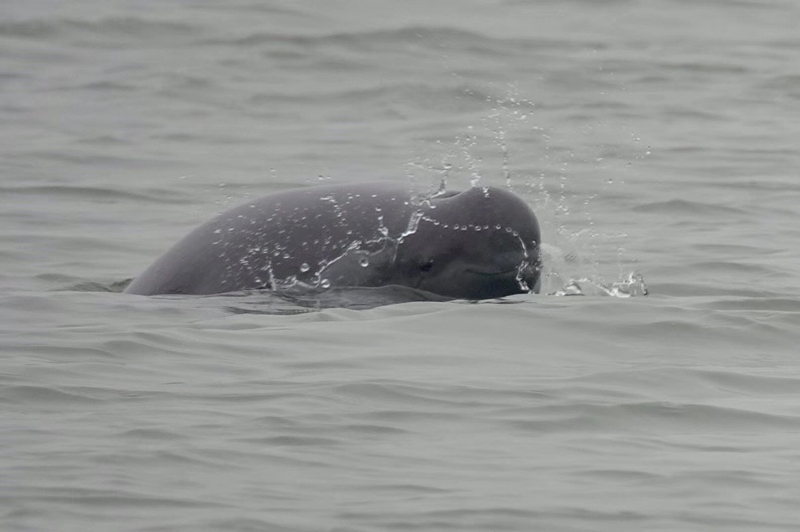
The finless porpoise swims in the old course of the Yangtze River in Swan Island, Hubei Province. Photo by Niu Yibin
On the sparkling Wuhan section of the Yangtze River, finless porpoises are in groups of three or five, chasing for food and swimming in the river in early spring. The finless porpoise has high requirements on the water environment and is known as the "giant panda in the water". After the implementation of the great protection strategy of the Yangtze River, with the improvement of water quality and the increase of fish, the once rare finless porpoise has gradually increased.
"The Yangtze River Economic Belt should embark on a new path of ecological priority and green development." Four years ago, General Secretary of the Supreme Leader gave directions and drew a blueprint for the development of the Yangtze River Economic Belt under the new situation in Hubei.
Sitting on the longest runoff mileage of the Yangtze River trunk line, Hubei is called the "waist of the Yangtze River" and shoulders the important mission of ensuring that "one reservoir of clear water is sent to the north and one reservoir of Qing Jiang water flows to the east". Jingchu earth keeps in mind the general secretary’s earnest entrustment, makes great efforts to further promote the high-quality development of the Yangtze River Economic Belt, and writes Hubei answer sheet.
Based on ecological protection, the face has taken on a new look.
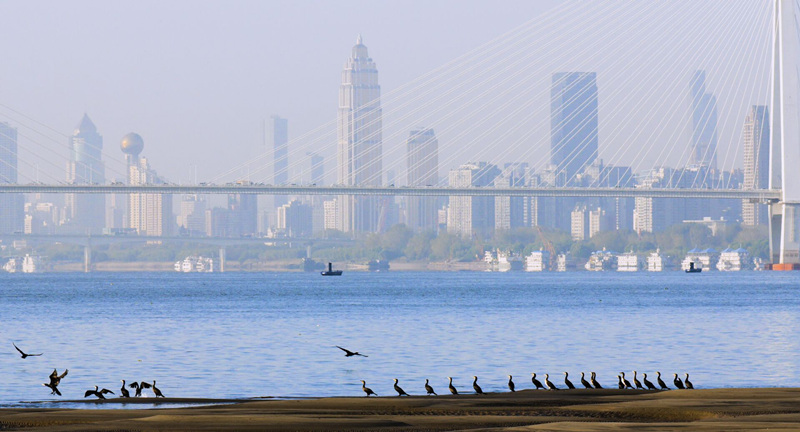
River view of Tianxingzhou Yangtze River Bridge in Wuhan. Photo courtesy of Wuhan Water Affairs Bureau
Wuhan Hongshan River Beach starts from Baishazhou Bridge in the west and ends at Yangsigang Bridge in the east, with a total length of 3.12 kilometers, which is the "final work" of the river beach construction in the central city of Wuhan.
"The river beach here is so beautiful!" Ms. Zhang, who lives in Baishazhou, is playing in the park with her 9-year-old daughter. "It used to be a wasteland, but now it has a new look, and everyone says yes."
After years of transformation, Wuhan Jiangtan has changed from a flood control beach to a baili gallery. The quiet Hankou River Beach, the romantic and warm Hongshan River Beach, the simple and simple Wuchang River Beach, the winding Hanyang River Beach and the picturesque Qingshan River Beach have become the ecological waterfront paradise of Jiangcheng people.
Looking back more than 600 kilometers to the upper reaches of the Yangtze River, the same gratifying changes also took place in Yichang. In spring, the warm sun spreads all over the earth, overlooking the Yangtze River Bridge in Wujiagang, Yichang. The vegetation on both sides is lush, the trees and flowers are scattered, and the boats on the green river are busy. Under the North Shore Bridge, the Yichang Yangtze River shoreline renovation and restoration project is about to open to the public. After the completion of the project, the Yangtze River coastline will add new beauty — — Yichang Dongdaemun Ecological Corridor.
Behind the "green clothes" on the coastline of the Yangtze River, it is inseparable from the all-out cracking of "chemical encircling the river" and the thunder rectification of illegal docks.
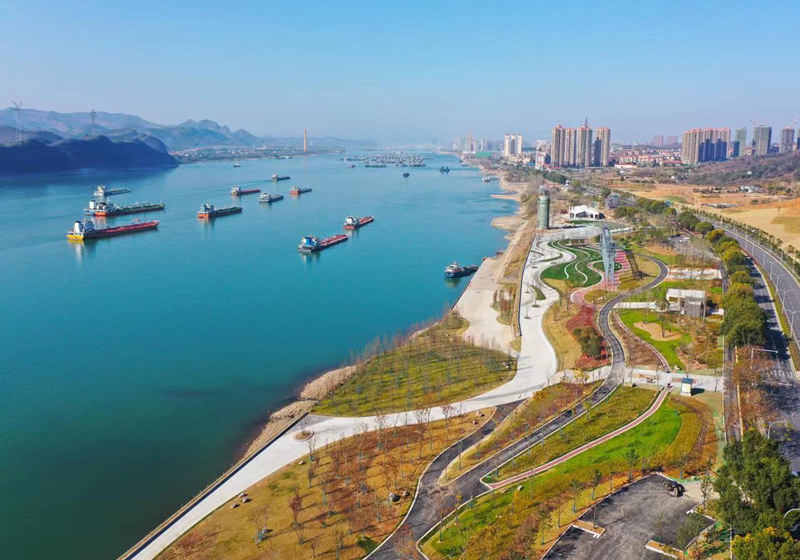
On April 19, 2022, it was photographed on the coastline of the Yangtze River, 8 kilometers away from Xiaoting District, Yichang City, Hubei Province. After the completion, the revetment along the river in Xiaoting District was picturesque. Photo courtesy of Propaganda Department of Yichang Municipal Committee
In 2017, Yichang City took the lead in starting the customs clearance, modification, relocation and transfer of 134 chemical enterprises within 1 km along the Yangtze River. Hubei Xingfa Group, which is good at fine phosphorus chemical industry, resolutely started the relocation of 70,000 tons of glyphosate and glycine plant in Linjiang Park. In the process of relocation, it implemented transformation and upgrading, and cultivated electronic chemicals and new materials from silicone. The economic benefits increased instead of falling.
At the port of Libu, Jingzhou, it is the peak period of port freight, and several cranes are unloading sand and gravel. The blue fully enclosed belt conveyor corridor, like two tentacles, extends from the storage yard to the river bank, realizing that "sand and gravel don’t fall to the ground, and sand can’t be transported". This "air transportation corridor" can not only collect sand and gravel, but also receive ship garbage.
Just a few years ago, there were 40 gravel docks and more than 20 building materials enterprises along the coastline where Libo Port was located. In order to solve the problem of small, scattered and chaotic gravel docks, Jingzhou City has built a gravel collection center, which makes "a sunny day covered with dust and a rainy day covered with mud" completely a thing of the past.
At present, the Jingzhou section of the Yangtze River, which is 483 kilometers long, is full of beautiful scenery. The ecological green corridor meanders along the river, and it is "beaded into a chain" with the Wenchuang Garden, Wanshou Park and Yangtze River Bridge at the ocean pier, showing "the Yangtze River is thousands of miles long and the beauty is in Jingjiang".
"Man and water struggle" has become "man and water depend on each other", and the change of the word difference shows the beauty of the Yangtze River after ecological improvement.
Taking the top ten landmark "campaigns" of the Great Protection of the Yangtze River as the starting point, the trunk line of the Yangtze River in Hubei Province banned 1211 illegal docks, vacated 149.8 kilometers of coastline, and restored 8.56 million square meters of ecology; By the end of last year, 5,186 of the 12,480 sewage outlets in Hubei section of the Yangtze River had been rectified, and the water quality in Hubei section of the main stream of the Yangtze River had been stable at Class II standard for two consecutive years. A beautiful picture of the Yangtze River is slowly unfolding.
Green development is the way to promote modernization
Luoshan Town, honghu city is bordered by the Yangtze River in the south and the Baili Honghu Lake in the north. The local people have made the lake their home and fishing for generations, and Yu Zhimu is one of the millions of fishermen in Honghu Lake.
Since 1996, Yu Zhimin has covered more than 2,000 mu of water in Honghu Lake area for purse seine farming. Under the strategy of "protecting the Yangtze River together and not developing it", Yu Zhimin, who has dealt with "fishing" all his life, bid farewell to the stormy water life with the fishermen in the same village and moved from the lake to the shore to continue raising crabs. Today, Honghu base, an old fisherman in charge, has become a demonstration base for localized cultivation of crab fry in Hubei Province.
Not being unemployed when landing, all the 31,952 fishermen who need to change jobs have completed their jobs and taken up "new rice bowls".
Driven by the transformation and upgrading, the city has also ushered in great changes.
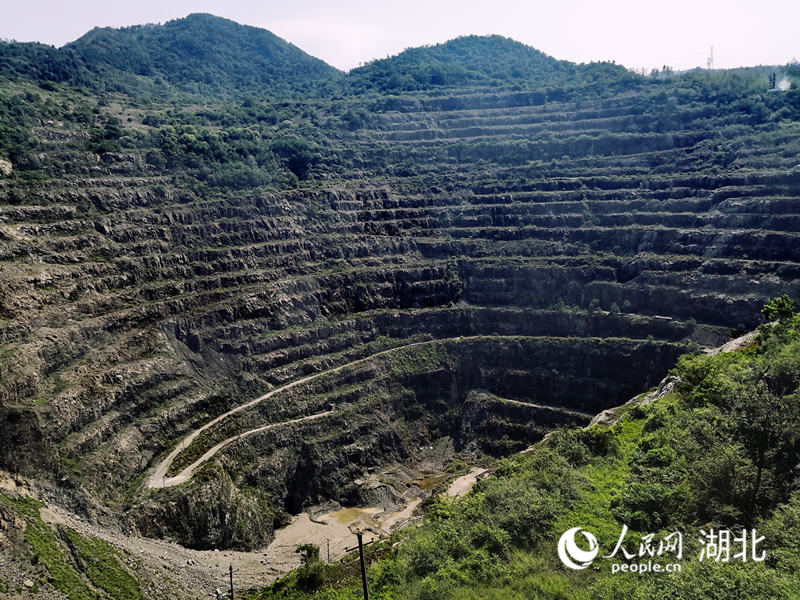
"Asia’s first tiankeng" in Huangshi National Mine Park, Hubei Province. Photo by Wang Guozhen
Huangshi, which is prosperous because of mines, is a traditional old industrial base that relies on resources. It has long relied on steel, coal and non-ferrous metals to support the industrial structure. Nowadays, the local government has inserted the wings of "technological transformation of 100 enterprises" to legislate for mine restoration, and "whoever develops will protect and whoever destroys will govern", forcing mining rights holders to implement ecological restoration and let old industrial bases open new branches and sprout.
The former location of Daye Iron Mine has now been transformed into a 4A-level tourist attraction Huangshi National Mine Park, and it has been listed as a "National Industrial Heritage Tourism Base", receiving more than 300,000 tourists every year.
The conversion of old and new kinetic energy is accelerated, and "low carbon" has become a new trend of green life.
Early in the morning, Li Ruyin carried a hoe and took several fellow villagers to the mountains to weed and protect bamboo forests. He is not only a villager in Jinkeng Village, Yanxia Township, Tongshan County, Xianning City, but also the "Lin Chang" of Nanzhu Base. "Can’t rest a day! I want to protect my ‘ Cash cow ’ 。” Li Ruyin said with a smile, "It is not a small sum to earn 50 yuan per mu a year. With bamboo, my annual income has doubled. "
The "cash cow" in Li Ruyin’s mouth is a 3,000-mu bamboo forest planted in barren hills, which is part of the carbon sink project of bamboo afforestation in Tongshan County. "Relying on bamboo forests to absorb carbon and spit oxygen, this project can absorb 6,500 tons of carbon dioxide every year. Those enterprises whose carbon emissions exceed the standard can purchase our emission reductions through Hubei Carbon Emissions Trading Center. " Li Ruhuo, one of the project investors and chairman of Tongshan Ruhuo Agricultural Science and Technology Development Co., Ltd. said.
A small bamboo, one end is connected with energy conservation and emission reduction, and the other end is connected with rural revitalization. Tongshan people like Li Ruyin are happy to "sell ‘ Carbon ’ Weng ". Today, there are more than 400,000 mu of bamboo carbon sequestration projects in Tongshan County, which has increased the income of more than 30,000 farmers and created a new way to get rich.
By the end of December 2021, the carbon market quota in Hubei had reached 365 million tons, with a total turnover of 8.651 billion yuan.
Scientific and technological innovation as the source to maintain vitality forever
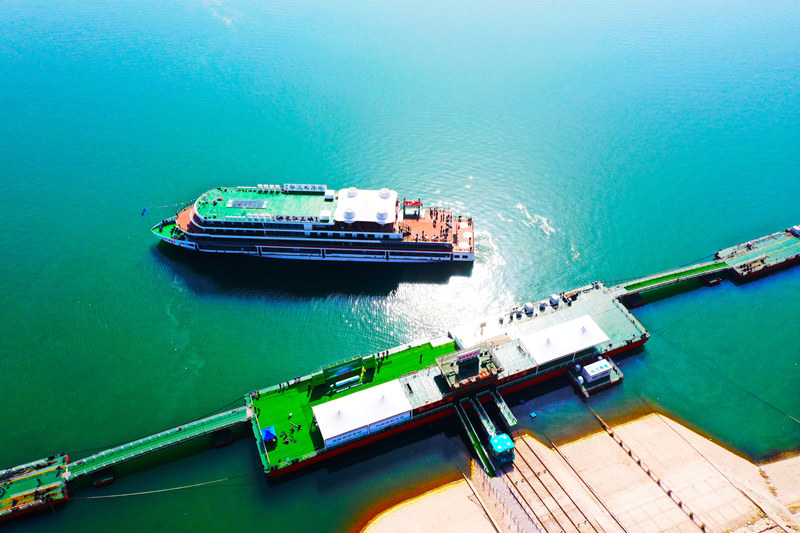
"Yangtze Three Gorges 1" is a new energy pure electric ship with the largest power battery capacity and the most advanced intelligence designed and built in the world. Photo courtesy of Propaganda Department of Yichang Municipal Committee
At 9 o’clock in the morning of March 29th, with a loud whistle, the pure electric tourist passenger ship with the largest electricity load in the world — — "Three Gorges on the Yangtze River No.1" made its maiden voyage at Zigui Xingang Wharf in Yichang City.
Compared with the traditional power cruise ship, "Yangtze Three Gorges 1" is driven by clean hydropower, which can replace about 530 tons of fuel oil every year and reduce harmful gas emissions by more than 1,600 tons. After it is put into operation, it will provide new experiences for tourists and serve the green and high-quality development of the Yangtze River Economic Belt.
On April 8, the container port area of Wuhan Yangluo Port was even more magnificent in the afterglow of the sunset. Foreign trade containers equipped with masks, non-woven fabrics and other medical supplies will sail directly to Japan from here.
Thanks to the technical upgrading of the system and the integrated operation of the first, second and third phases of the port area, the annual container throughput of Yangluo Port has increased from 760,000 TEUs in 2013 to 2.48 million TEUs last year. According to statistics, the average waiting time of ships in Yangluo Port has been reduced by 12 hours, the working efficiency of the wharf has been improved by 30%, and the golden waterway has truly achieved golden benefits.
At present, relying on Yangluo Port, Hubei connects the "Belt and Road" with the Yangtze River Economic Belt by multi-channel multimodal transport, and builds a Wuhan port-type national logistics hub that connects things, radiates the whole country and connects the international community. In the first quarter of this year, the shipment volume of China-Europe train (Changjiang) increased by 60% compared with the same period of last year. By the end of the 14th Five-Year Plan, the port cargo throughput in Hubei Province is expected to reach 250 million tons, and the container throughput will strive to reach 5 million TEUs.
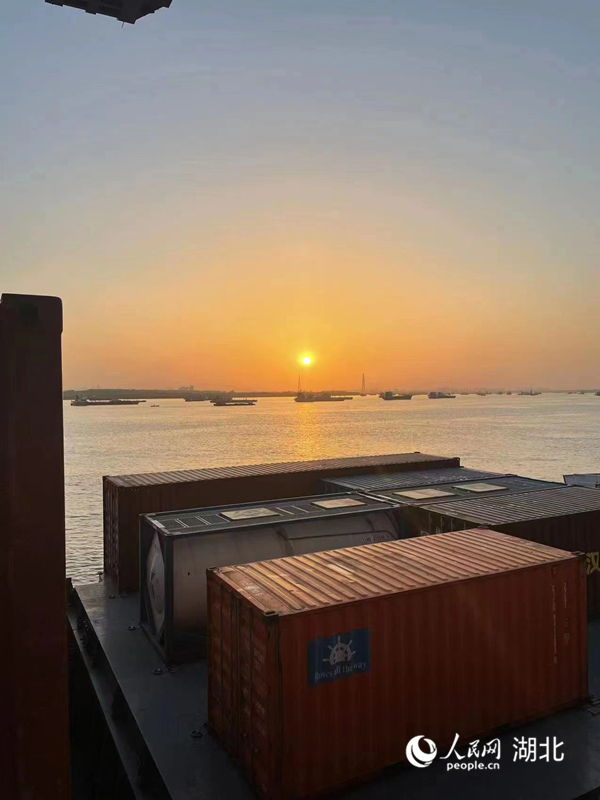
Wuhan Yangluo Port in the Afterglow of Sunset. Zhou Wei
On the bank of the Yangtze River, a number of strategic emerging enterprises are gestating and growing, and trillions of industrial clusters such as "optical core screen end network", big health and automobile manufacturing are accelerating.
Wuhan East Lake High-tech Zone is full of innovation. This is the first batch of national high-tech zones and the Wuhan area of China (Hubei) Pilot Free Trade Zone, and it has been approved as a national optoelectronic information industry base, a national bio-industry base and a national storage base, also known as "China Optical Valley".
At present, Hubei leads the development of emerging industries with innovation drive, and accelerates the establishment of Wuhan’s nationally influential science and technology innovation center and East Lake comprehensive national science center; There are 30 national key laboratories in the province, ranking fourth in the country in total, and there are nearly 15,000 high-tech enterprises … …
The Yangtze River is long and the clear water is full; The sound of entrustment is inspiring. Jingchu Land is faithfully implementing the decision-making arrangements of the CPC Central Committee on the development of the Yangtze River Economic Belt, maintaining historical patience and strategic determination, carrying out a blueprint to the end, and writing a new chapter in Hubei’s high-quality development.
关于作者